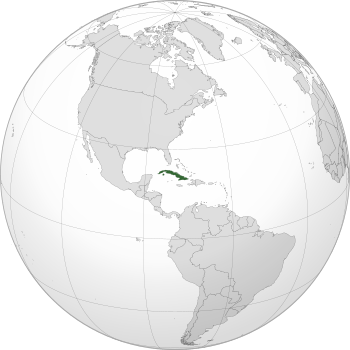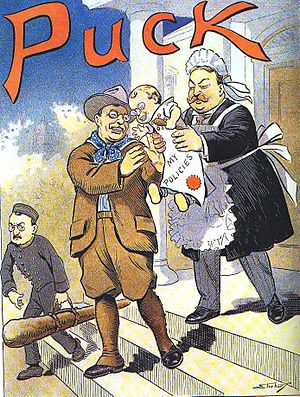Provisional Government of Cuba facts for kids
Quick facts for kids
Provisional Government of Cuba
|
|||||||||
|---|---|---|---|---|---|---|---|---|---|
| 1906–1909 | |||||||||
 |
|||||||||
| Status | United States military occupation | ||||||||
| Capital | Havana | ||||||||
| Common languages | Spanish, English | ||||||||
| Government | Military occupation | ||||||||
| Provisional Governor | |||||||||
|
• 1906
|
William H. Taft | ||||||||
|
• 1906–1909
|
Charles E. Magoon | ||||||||
| Historical era | Modern Era | ||||||||
|
• US invasion
|
28 September 1906 | ||||||||
|
• Full withdrawal
|
6 February 1909 | ||||||||
|
|||||||||
| Today part of | Cuba | ||||||||
| Second Occupation of Cuba | |
|---|---|
| Part of the Banana Wars | |
 A 1909 cartoon from Puck showing President Theodore Roosevelt, dressed in his Rough Riders uniform, handing off his policies to the future president, William H. Taft. William Loeb, Jr. is at left, holding Roosevelt's "Big Stick." |
|
| Type | Military occupation |
| Location | Cuba |
| Objective | Protect United States interests, stabilize Cuba, hold free elections |
| Date | 1906–1909 |
| Executed by | United States |
The Provisional Government of Cuba was a time when the United States military took control of Cuba. This period lasted from September 1906 to February 1909. It is also known as the Second Occupation of Cuba.
The U.S. stepped in when Cuba's government, led by President Tomás Estrada Palma, fell apart. U.S. President Theodore Roosevelt sent troops to Cuba. Their main goals were to stop fighting among Cubans and protect American businesses there. They also wanted to help Cuba hold fair elections to create a new, proper government. After José Miguel Gómez was elected president in November 1908, the U.S. felt Cuba was stable. American troops then left the island by February 1909.
Before this, there was an earlier U.S. occupation from 1898 to 1902. That one happened after the Spanish–American War ended. It lasted until Cuba became an independent republic.
Contents
Why the U.S. Stepped In
The United States had a special role in Cuba because of a treaty. This was the Cuban–American Treaty of Relations of 1903. Cuba and the U.S. signed it in 1903. Article III of this treaty said:
The Government of Cuba agrees that the United States can step in to protect Cuba's independence. This also includes making sure there is a government that protects people's lives, property, and freedom. It also helps Cuba meet its duties from the Treaty of Paris.
Problems started during Cuba's presidential election in September 1905. President Estrada Palma and his party cheated to win against the liberal candidate, José Miguel Gómez. Because of this, the liberals started a revolt in August 1906. Both sides wanted the U.S. military to get involved. The government hoped for help to stop the revolt. The rebels hoped for new, fair elections.
President Roosevelt was not eager to send troops at first. He sent his Secretary of War, William Howard Taft, and Assistant Secretary of State Robert Bacon. They went to Cuba to try and find a peaceful solution. They arrived on September 19 and met with leaders from both sides. When Estrada Palma realized Roosevelt would not fully support him, he resigned on September 28, 1906.
The U.S. Takes Charge
The day after President Palma resigned, Secretary Taft used the 1903 treaty. He set up the Provisional Government of Cuba and named himself the temporary governor. Taft announced this new government on September 29, 1906. He explained that the U.S. was stepping in because Cuba had no government and there was a lot of disorder.
Taft said the U.S. government would only stay long enough to bring back order and trust. Then, they would hold elections to choose a permanent government. He promised that the Cuban flag would still fly. Most Cuban government offices would keep working as before. The courts would also continue to operate. Taft asked all Cubans to help bring back peace and order.
On October 23, 1906, President Roosevelt officially approved Taft's actions. The U.S. Navy sent Marines to Cuba. These Marines, led by Colonel Littleton Waller, protected American citizens. They also patrolled the island until the regular army arrived. The rebels did not fight back. They saw the American help as a good sign. U.S. Army General Frederick Funston oversaw the rebels' surrender. He was later replaced by General James Franklin Bell.
Life During the Occupation
On October 6, the first army soldiers arrived. This force was first called the Army of Cuban Intervention. Taft later renamed it the Army of Cuban Pacification on October 15. The U.S. planned to send 18,000 soldiers. However, the number of troops in Cuba never went above 425 officers and 6,196 enlisted men. Many of these soldiers had fought in the Philippine–American War. They kept strict rules to prevent problems.
Since the rebels had already given up their weapons, the Americans focused on building. They built new roads and military outposts. About 92 kilometers (57 miles) of new roads were built. The army set up about thirty posts in both cities and rural areas. This included Guantanamo Bay. The main headquarters was at Camp Columbia, near Havana. The military leaders were careful to prevent diseases like typhoid and malaria among their troops.
Most troops were in Santa Clara Province. This area was important because it had many people and was close to railways and roads. These routes were used to transport sugar cane, which was a major American business in Cuba.
Preparing for the Future
To get ready for any future unrest, the Americans created a Military Intelligence Division (MID). This group gathered information about Cuba's military and resources. They made a list of everyone who took part in the 1906 revolt. They also created detailed maps of Cuba's land. They took photos of important railroad bridges and waterways.
Other U.S. troops helped reorganize and train the Cuban Rural Guard (Guardia Rural Cubana). They worked to improve discipline and morale. They also tried to stop promotions based on politics. However, this effort did not have a big impact. The Cuban government decided to focus on creating a strong, permanent Cuban army instead of the Rural Guard. Some people worried that a strong army could be used for political reasons. But others argued it was needed for long-term stability.
Elections and Withdrawal
On October 13, 1906, Charles Edward Magoon became Cuba's provisional governor. He decided that Cuba was stable enough to hold elections. Local elections happened on May 25, 1908. The presidential election was on November 14. The U.S. military supervised both elections.
The elections went smoothly. José Miguel Gómez was elected president. He took office on January 28, 1909. The U.S. troops then started to leave over the next few weeks. The last American forces left Cuba on February 6, 1909.
President Roosevelt was very happy with how quickly the operation went. He said it was the fastest movement of troops overseas by the U.S. government. This success made him believe even more in organizing U.S. forces under a central command.
Baseball During the Occupation
During the U.S. occupation, a famous Afro-Cuban baseball pitcher named José de la Caridad Méndez played. In December 1908, he faced the visiting Cincinnati Reds team. In a three-game series, he pitched 25 innings without giving up any runs. This included a game where he only allowed five hits and no runs.
See also
 In Spanish: Segundo gobierno militar estadounidense en Cuba para niños
In Spanish: Segundo gobierno militar estadounidense en Cuba para niños



